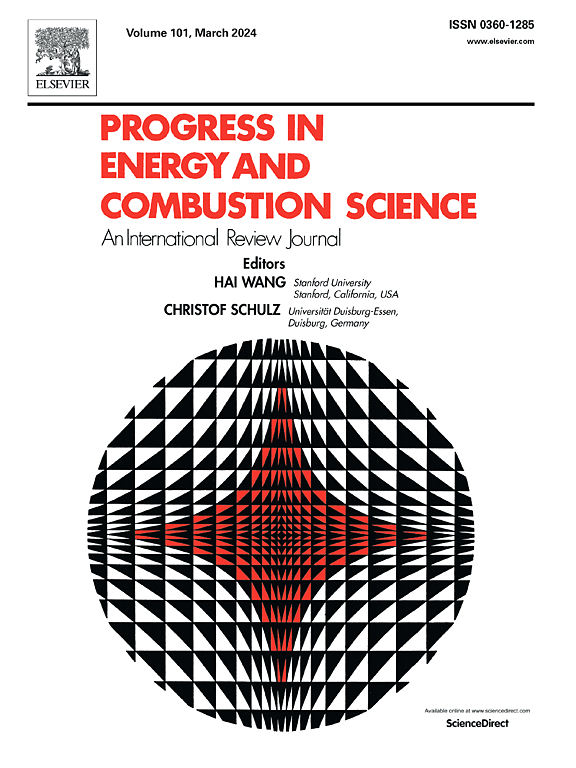Flame stabilization and emission characteristics of ammonia combustion in lab-scale gas turbine combustors: Recent progress and prospects
IF 37
1区 工程技术
Q1 ENERGY & FUELS
引用次数: 0
Abstract
Global climate change forces all countries to push the process of de-carbonization. Ammonia, which is carbon free and a potential hydrogen carrier, is proposed as a prospective fuel for the power devices to realize the green economy. It also exhibits very good fuel properties, including its storage condition, energy density. However, two main challenges, the difficulties of flame stabilization and potential high fuel NOx production, still need to be tackled in its application in gas turbines. In the last decades, valuable investigations were conducted to address characteristics of NH3/air flame stabilization in swirl combustors as well as the combustion enhancement by cofiring with active molecule like CH4 and H2, applying plasma assistance. These measures mainly improve the flame resistance to the flow and increase the key radicals at flame base, which may provide possible solutions to the combustion chamber design. The inherent mechanisms of fuel NOx production are highlighted by the HNO channel with the presence of OH radical. One promising strategy to mitigate NOx in gas-turbine like combustor is the staged combustion by staging the air or fuel, which may also fit for the practical combustion chamber. The high-pressure condition and plasma assistance were found to show positive influence on both flame stabilization and NOx control. This review also emphasizes the fundamental research issues for ammonia fuel and proposes some future research prospects towards the development of more robust, reliable, and low NOx combustion technologies relevant to gas turbines.
实验室规模燃气轮机燃烧器中氨燃烧的火焰稳定和排放特性:最新进展和前景
全球气候变化迫使所有国家推进去碳化进程。氨不含碳,是一种潜在的氢载体,被建议作为动力设备的未来燃料,以实现绿色经济。氨是一种无碳的潜在氢载体,被认为是实现绿色经济的动力设备的前瞻性燃料,它还表现出非常好的燃料特性,包括储存条件和能量密度。然而,在燃气轮机中应用这种燃料仍需解决两个主要挑战,即火焰稳定困难和燃料可能产生较高的氮氧化物。在过去几十年中,针对漩涡燃烧器中 NH3/空气火焰稳定的特性以及通过与 CH4 和 H2 等活性分子共燃、应用等离子体辅助来增强燃烧的问题进行了大量研究。这些措施主要是改善火焰的流动阻力,增加火焰底部的关键自由基,从而为燃烧室设计提供可能的解决方案。燃料产生氮氧化物的内在机制突出表现为 HNO 通道和 OH 自由基的存在。在类似燃气轮机的燃烧器中,缓解氮氧化物的一种有前途的策略是通过对空气或燃料进行分段燃烧,这也可能适用于实际的燃烧室。研究发现,高压条件和等离子体辅助对火焰稳定和氮氧化物控制都有积极影响。本综述还强调了氨燃料的基础研究问题,并提出了一些未来的研究前景,以开发与燃气轮机相关的更稳健、可靠和低氮氧化物燃烧技术。
本文章由计算机程序翻译,如有差异,请以英文原文为准。
求助全文
约1分钟内获得全文
求助全文
来源期刊

Progress in Energy and Combustion Science
工程技术-工程:化工
CiteScore
59.30
自引率
0.70%
发文量
44
审稿时长
3 months
期刊介绍:
Progress in Energy and Combustion Science (PECS) publishes review articles covering all aspects of energy and combustion science. These articles offer a comprehensive, in-depth overview, evaluation, and discussion of specific topics. Given the importance of climate change and energy conservation, efficient combustion of fossil fuels and the development of sustainable energy systems are emphasized. Environmental protection requires limiting pollutants, including greenhouse gases, emitted from combustion and other energy-intensive systems. Additionally, combustion plays a vital role in process technology and materials science.
PECS features articles authored by internationally recognized experts in combustion, flames, fuel science and technology, and sustainable energy solutions. Each volume includes specially commissioned review articles providing orderly and concise surveys and scientific discussions on various aspects of combustion and energy. While not overly lengthy, these articles allow authors to thoroughly and comprehensively explore their subjects. They serve as valuable resources for researchers seeking knowledge beyond their own fields and for students and engineers in government and industrial research seeking comprehensive reviews and practical solutions.
 求助内容:
求助内容: 应助结果提醒方式:
应助结果提醒方式:


